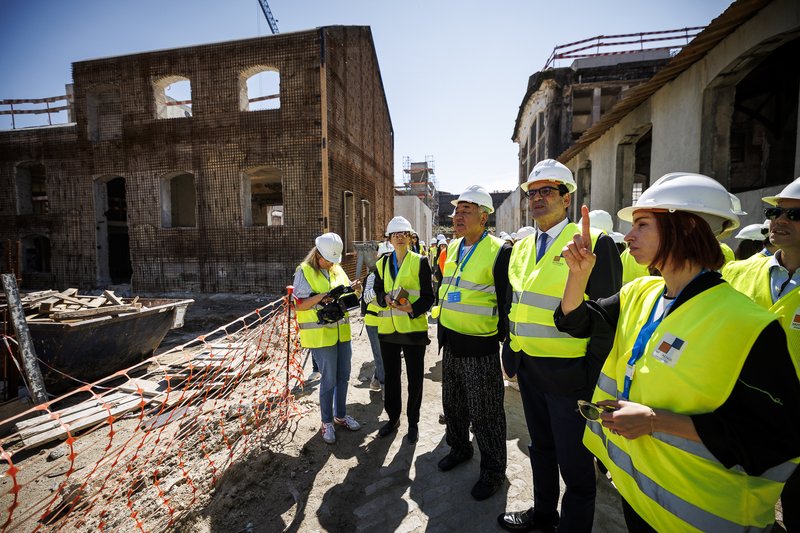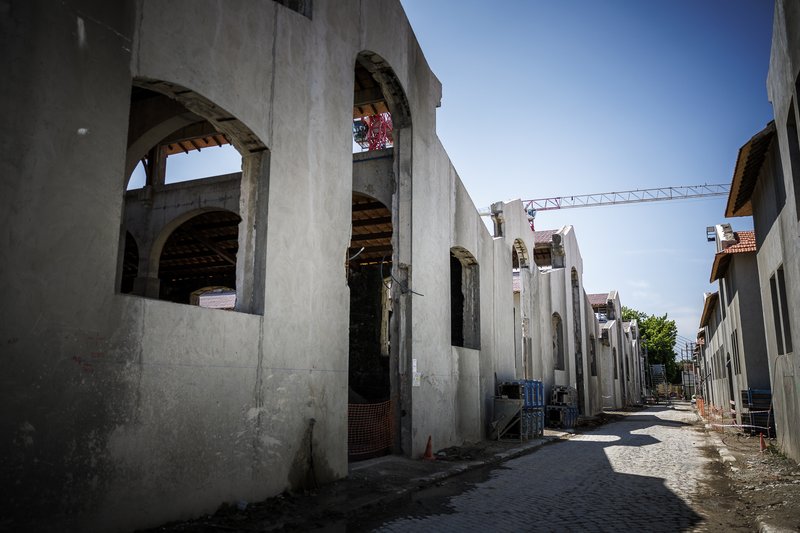Matadouro goes into culture mode to anchor Campanhã's metamorphosis
Article
'The Matadouro (former slaughterhouse) is the city we want. Here I find everything: I find culture, cohesion and economy.' Among the walls made of memory and construction from scratch, Campanhã is witnessing a new destiny, shaped by an investment of EUR 40 million, a revitalisation strategy and an effective plan to overcome barriers to build the city where it is looking for ways to grow.
During a visit to the space on Thursday morning, accompanied by the architect who designed the project, Japanese Kengo Kuma, the Mayor of Porto recalled that the conversion of the old Matadouro is a job that 'we've been doing with the communities, so that they understand that this isn't just a space with memory. It's going to be a space where people will be working, where they can hold community activities, where there will be cultural activities'.
A space open to all, for enjoyment, and also 'a new street in the city'. 'People who currently live in Corujeira and want to take the metro will no longer have to go on a hellish journey under viaducts and will be able to share this space', Rui Moreira says.

Emphasising that 'this is a place where we need to grow the city', the Mayor recalled how 'these people felt in despair, abandoned', and what we have been doing, through interventions like this but also with Parque Oriental, the acquisition of the STCP land in São Roque, the rehabilitation of Cerco or the requalification of Praça da Corujeira, is 'make people believe that there is a future for this area'.
'This is the anchor project, not just for Campanhã, but for a political project that seemed somewhat unlikely', he emphasises, not forgetting how the building 'was about to be demolished' so that a 'China Town' could be born there.
It will be fully operational by the beginning of 2026, fulfilling our expectations.'
Out of a total area of 26,000 square metres, 20,500 will be built. For the 8,000 square metres it will take over, the municipality will perform the extension of the Municipal Gallery; an extension of the Museum of Convergences, where the private collection of Távora Sequeira Pinto will be deposited; a collection and depository of works of art; an educational space and another for culture and social practices; as well as an area for municipal workshops.
'And we were also able to take our percentage of the area and include the new [Public Safety] Police station, developed with the Ministry of Internal Affairs', Rui Moreira underlined.
With the works due to be finished by the end of the year, the Mayor expects another '12 to 15 months to have the Gallery and Museum up and running'. "We can say that it will be fully operational by the beginning of 2026, fulfilling our expectations', Rui Moreira states.

The remaining 12,500 square metres of equipment will be operated by Mota-Engil, the company that won the public tender to convert the old slaughterhouse, where offices will be set up with capacity for up to 1,600 people, as well as commercial and catering spaces.
The EUR 40 million investment, borne by the company, includes an operating period of 30 years, after which the entire space will revert to the municipality.
Only the construction of the overpass that will connect to the other side of the VCI will take place in 2025, given the need to reinforce the supporting wall. With pedestrian and bicycle access ways, it is part of an internal, public route that will allow circulation between Rua de São Roque da Lameira and the Dragão Metro station and its car park, and includes the construction of a new building.
[We tried] to bring new enthusiasm to the city'.
From the Tokyo Olympic Stadium to Campanhã, the architect responsible for the project took on the mission of intervening 'in a part of the city that is a kind of forgotten place to which we wanted to give a new centre'.
Kengo Kuma says that 'the biggest challenge was to preserve the old building because it's not an elegant building, but we tried to find a beauty in that antique look' and, in tune with new developments being born there, 'to bring a new enthusiasm to the city'.
The project is a partnership between the Japanese architect and the Portuguese firm OODA, and Kengo Kuma even recognises that 'there are many similarities, lots of nature, lots of natural light' in the two cultures.
As well as sustainability, which has guided the work carried out by GO Porto from the outset. In the words of the Japanese architect, 'preserving and using the old building is a very sustainable approach', as is the use of ventilation and natural light, or the use of tiles taken from demolished rooftops and integrated into the pavement.
When this whole new world to the east opens up to the population, the past of more than 120 years will remain in what was the Municipal Slaughterhouse and the future will be made in the M-ODU.